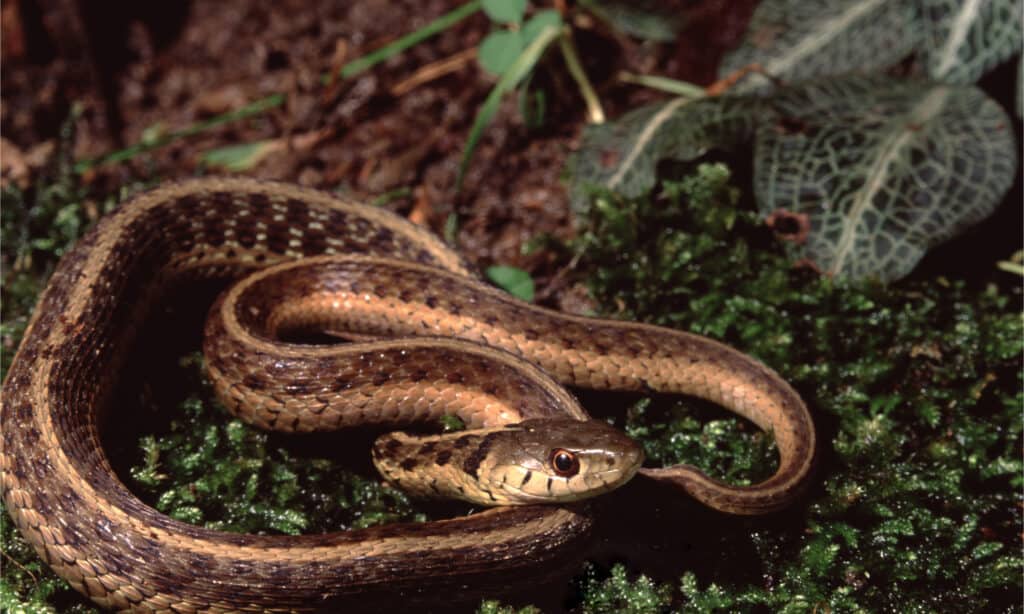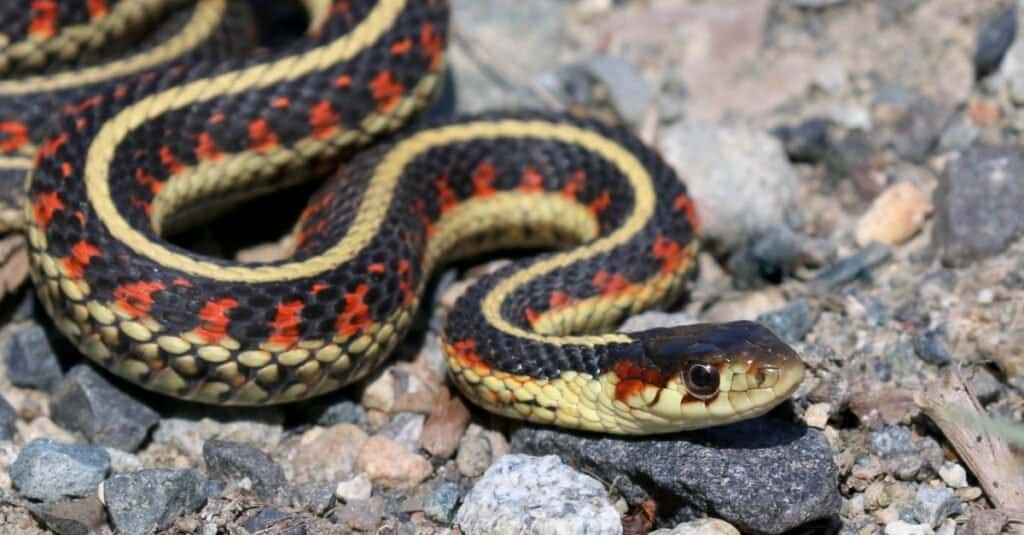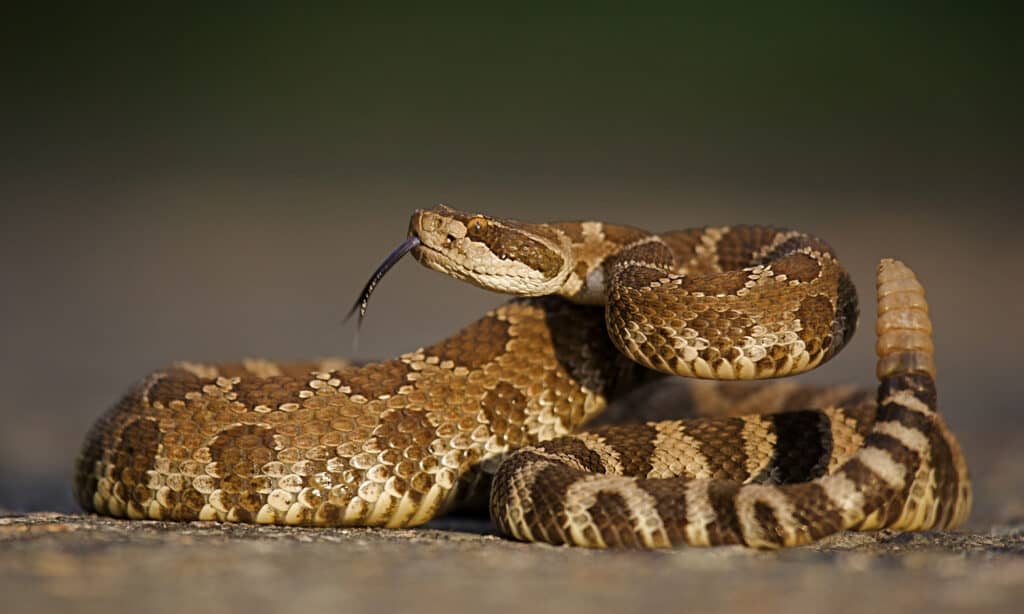Summer is fast approaching and most Oregonians are thrilled. However, while the summer days can be lovely, they also come with their fair share of snakes. According to the Oregon Department of Fish and Wildlife, the state is home to 15 native snake species that are spread across Oregon’s plains and mountains.
Luckily, of this number, only 1 is really dangerous. However, 4 other species have venom that they use to kill their prey. This means that they could also hunt and kill small mammals and pets. If you’re in the state, take a look at Oregon’s 5 largest and most dangerous snakes.

Now that you’ve seen a preview, read on for more information about these snakes, including their habitats, prey, and size.
#5 Night Snake

Night snakes, found in Oregon’s deserts, are nonvenomous but look a lot like rattlesnakes.
©Matt Jeppson/Shutterstock.com
Night snakes (Hypsiglena torquate) are dark snakes that look very much like rattlesnakes. Although their heads are flat, they appear triangular. They are usually gray, beige, or brown. On average, they are 12-26 inches long.
Night snakes are venomous as they are rear-fanged colubrids. They use their venomous saliva to subdue their prey. However, their venom is rather mild and not dangerous to humans. Several animals, such as cats and hedgehogs are also immune to the night snake’s venom. However, if you suspect a night snake has bitten your pet hedgehog or cat, still take it to the vet.
In Oregon, night snakes are commonly found in arid desert scrub habitats. They are also found near rocky outcrops. During the day, they like to hang around rocky crevices to wait for cooler weather. As you can probably tell from the species’ name, they are more active at night. However, it is also common to spot them at dawn, dusk, and late afternoons, given that the weather is cool.
Night snakes feed on small mammals, toads, lizards, salamanders, and even small snakes. Due to their nocturnal habits, they do not make really good pets.
#4 Western Terrestrial Garter Snake

Western terrestrial garter snakes are mildly venomous and live in a variety of habitats across Oregon.
©Hunter Kauffman/Shutterstock.com
Western terrestrial garter snakes (Thamnophis elegans vagrans) are a highly variable species. Although they mostly have orange, white, or yellow dorsal stripes, as well as a single stripe of the same color on each side, they are notoriously difficult to identify. This species of snake is mostly medium in size, measuring anywhere from 18 to 41 inches.
Like many other garter snakes, western terrestrial garter snakes have mildly venomous saliva. Their venom is strong enough to weaken their prey but is harmless to humans. That is not to say that they are powerless against humans. If a western terrestrial garter snake senses a threat, it will spray musk which is often mixed with feces.
There are at least 5 subspecies of western terrestrial garter snakes and about 4 in Oregon alone! The species is known to live in a variety of habitats. Some subspecies are more water-inclined than others. Most western terrestrial garter snakes live in moist locations such as lakes, streams, and marshes but a few others live farther away.
Their varying choices of habitats affect what they eat. Western terrestrial garter snakes that live closer to water feed on fish, tadpoles, leeches, and frogs. The more terrestrial-inclined snakes feed on small lizards, small mammals, salamanders, and slugs.
#3 Northwestern Garter Snake

Northwestern garter snakes are mildly venomous and can be found in Rogue Valley, as well as city parks and suburban areas.
©Liz Weber/Shutterstock.com
The northwestern garter snake (Thamnophis ordinoides) is another species of garter snake that is endemic to North America. The species is in the Colubridae family and is one of the most variable species in the world. They have mild venom that allows them to capture their prey. However, like many garter snakes, their venom doesn’t pose a threat to humans.
Generally, northwestern garter snakes prefer the edges of forest clearings as well as meadows. This is because the species prefers to live in areas with heavy vegetation. They often leave their habitats to seek sunny areas to bask in. In Oregon, northwestern garter snakes can hang out in city parks and suburban areas. You can also find them in the Rogue Valley and its environs.
Northwestern garter snakes are carnivorous and feed on small mammals, fish, insects, birds that they can catch, and frogs. They are calm and make good pets, even for beginners. They are easy to feed and become quite accustomed to handling. If you come across a northwestern garter snake in the wild, it will do its best to escape you, so you do not need to fear it.
#2 Common Garter Snake

Common garter snakes are mildly venomous and found in Oregon’s forest edges and meadows close to water.
©iStock.com/randimal
Unlike rattlesnakes, the common garter snake (Thamnophis sirtalis) is thin and medium in size. On average, they grow to 4 feet. The species is unique due to its many colors. They could be yellow, red, gold, brown, black, blue, or orange.
Like most garter snakes, they possess mild neurotoxic venom that is basically harmless to humans. They use their venom to subdue the many animals that they prey on. However, if you pick a wild common garter snake up, it could very well bite you.
Common garter snakes eat earthworms, slugs, frogs, toads, salamanders, grasshoppers, newts, lizards, and many more. If you’re looking out for a common garter snake in Oregon, you’ll find them at forest edges and meadows close to water. Common garter snakes can also inhabit coniferous forests and valleys. They are also known for their docile natures. A lot of garter snakes in captivity do not mind handling. They are easy to feed and care for, which makes the species good pets.
#1 Most Dangerous Snake in Oregon: Western Rattlesnake

Western rattlesnakes are Oregon’s most venomous snake and are found all over the state.
©Tom Reichner/Shutterstock.com
Finally, introducing the most dangerous snake you don’t want to meet in Oregon this summer, which also happens to be one of the state’s largest.
The western rattlesnake (Crotalus viridus), also known as the prairie rattlesnake, is Oregon’s most venomous snake. Don’t confuse the species should with western diamondback rattlesnakes. Though very similar to the prairie rattlesnake, the western diamondback is distinguishable by its wider body, larger patches, flatter face, and more even distribution of black and white stripes.
Western rattlesnakes are all over Oregon but they usually live in higher numbers near cliffs, downed logs, or rocks. The species is famous for its extremely potent venom. They often use up to 20-55 percent of their total venom capacity in a single bite! Western rattlesnakes are often considered aggressive, but like most rattlesnakes, they are only quick to attack if they feel threatened.
Prairie rattlesnakes frequently grow to three feet or even longer, but the largest one ever found was just short of five feet long. You can recognize this snake by its thin neck, triangular head, and of course, the rattle.
Like other rattlesnakes, the western rattlesnake will rattle its tail to warn of an attack. If you come across this large and potentially dangerous snake in Oregon this summer, stay calm, and slowly back away. If you’re hiking, be sure to take extra care to avoid rattlesnakes.
Summary of Oregon’s 5 Largest and Most Dangerous Snakes
| Rank | Name | Length | Habitat |
|---|---|---|---|
| #1 | Western/Prairie Rattlesnake | 3-5 feet | Near cliffs, downed logs, or rocks |
| #2 | Common Garter Snake | Up to 4 feet | Forest edges and meadows close to water |
| #3 | Northwestern Garter Snake | Up to 2 feet | Edges of forest clearings and meadows |
| #4 | Western Terrestrial Garter Snake | 18-41 inches | Most subspecies live near lakes, streams, and marshes but some live farther away |
| #5 | Night Snake | 12-26 inches | Arid, desert scrub areas |
The photo featured at the top of this post is ©
Discover the "Monster" Snake 5X Bigger than an Anaconda
Every day A-Z Animals sends out some of the most incredible facts in the world from our free newsletter. Want to discover the 10 most beautiful snakes in the world, a "snake island" where you're never more than 3 feet from danger, or a "monster" snake 5X larger than an anaconda? Then sign up right now and you'll start receiving our daily newsletter absolutely free.
Thank you for reading! Have some feedback for us? Contact the AZ Animals editorial team.






